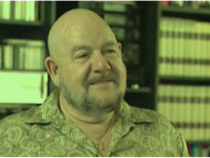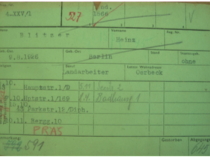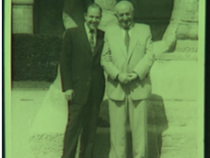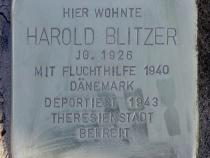Location
Alexanderstraße 43
District
Mitte
Born
09 August 1926 in Berlin
Deportation
on 01 October 1943
to
Theresienstadt
Survived
Harold Blitzer (whose given names were Heinz Martin) was born on 9 August 1926 in Berlin. His family was comfortably off; they lived at 89 Kastanienallee, where his father, Leo, ran a goose and poultry business. After a few years he opened a second shop at 141 Schoenhauser Allee. Business was so good that Leo closed the two shops in 1933 and opened new and much larger premises at 137 Schoenhauser Allee.
As a result of the boycot of Jewish businesses, customers stayed away and, according to Leo, his takings went down by half. In 1935, the family moved to 57 Schoenhauser Allee . In the same year, Polish poultry exports were stopped and his income was again drastically reduced. At the beginning of 1937 he was forced to sell his business. In order to feed his family he begann to trade in cloth remnants, which he sold to textile firms to earn a living.
The discrimination of the Jews did not only affect the Blitzer family's financial situation; it changed their whole way of life. Harold reported that he did not experience any form of anti-semitism before 1932, whereas by 1934 Jews could no longer go to the cinema, the theatre or to cafés. In 1937, Harold had to leave his old school after being intimidated by both teachers and fellow pupils. He then attended a Jewish school.
From 1938 onwards, the Nazi persecution hit the Blitzer family, now living at 43 Alexanderstrasse, even harder. In the so-called „Poland action“ on the night of 28 October 1938, thousands of Polish Jews in Berlin and other cities were arrested and expelled to the Polish border. According to Harold, Lilli, who was a Polish citizen, was arrested on the street and banished to Poland, where relatives looked after her. Harold and his parents were not expelled.
In December 1939, the family received the news that Harold had been selected for a children's transport. He was able to leave for Denmark on 6 February 1940 on a transport organised by the „Women's League for Peace and Freedom“. Together with a group of children he was taken to the island of Fyn, where each child was allotted to a farm where it lived and worked. This was intended as preparation for emigration to Palestine and life in a Kibbutz.
In April 1940, German troops invaded Denmark; deportations begann in 1943. On 1 October 1943, Harold was arrested by the Danish SS and deported along with other „League“ children in a cattle truck to the south. On 5 October 1943 the train arrived in the ghetto Theresienstadt. There, Harold was given farm work to do: He chopped wood, worked in the gardens and in the stables. On 14 April 1945 the Danish Jews were fetched from Theresienstadt by a rescue team of the Swedish Red Cross and taken in the so-called „white buses“ (the Bernadotte Transports) to Malmö in Sweden. Here they stayed for a month and were then taken back to Denmark, where the children and adolescents were put in Danish foster families. With the help of his foster family, Harold found an apprentice job in a car repair workshop and moved into a hostel for young adults. Shortly after, Leo and his American relatives contacted Harold. Leo's cousin invited Harold to emigrate to the USA and helped him with the application for a visa. It took nearly a year for the visa to be granted. At the beginning of December 1946 he emigrated to New York.
Harold changed jobs frequently in the States. He worked in a garage, then in cafes and restaurants, later as a hired help, as a cashier and as a waiter. When the Korean War broke out on 25 June 1950, Harold was called up but never drafted overseas. In 1952 he returned to civilian life, found a job as a sales representative and in 1954 left the US and moved to Frankfurt am Main. A few years later he opened a car salesroom with a companion. But in 1963 he returned to the United States, settled in Florida and then moved to Las Vegas, where he first went into real-estate and later, around 1975, worked in advertising for casinos.
In the early 1980s, Harold became aware that more and more often, the Holocaust was claimed to be a lie. He decided that it was his duty to tell his story and pass on his experiences and thus help prevent the Nazi crimes from being forgotten. He became involved in educational projects, took part in conferences and fought against the negation of the Holocaust.
He was not a happy man. He never married, as he found it difficult to share his life with someone who had not experienced what he had been through. He had friends but no family and was very lonely. We do not know if or when he died.
As a result of the boycot of Jewish businesses, customers stayed away and, according to Leo, his takings went down by half. In 1935, the family moved to 57 Schoenhauser Allee . In the same year, Polish poultry exports were stopped and his income was again drastically reduced. At the beginning of 1937 he was forced to sell his business. In order to feed his family he begann to trade in cloth remnants, which he sold to textile firms to earn a living.
The discrimination of the Jews did not only affect the Blitzer family's financial situation; it changed their whole way of life. Harold reported that he did not experience any form of anti-semitism before 1932, whereas by 1934 Jews could no longer go to the cinema, the theatre or to cafés. In 1937, Harold had to leave his old school after being intimidated by both teachers and fellow pupils. He then attended a Jewish school.
From 1938 onwards, the Nazi persecution hit the Blitzer family, now living at 43 Alexanderstrasse, even harder. In the so-called „Poland action“ on the night of 28 October 1938, thousands of Polish Jews in Berlin and other cities were arrested and expelled to the Polish border. According to Harold, Lilli, who was a Polish citizen, was arrested on the street and banished to Poland, where relatives looked after her. Harold and his parents were not expelled.
In December 1939, the family received the news that Harold had been selected for a children's transport. He was able to leave for Denmark on 6 February 1940 on a transport organised by the „Women's League for Peace and Freedom“. Together with a group of children he was taken to the island of Fyn, where each child was allotted to a farm where it lived and worked. This was intended as preparation for emigration to Palestine and life in a Kibbutz.
In April 1940, German troops invaded Denmark; deportations begann in 1943. On 1 October 1943, Harold was arrested by the Danish SS and deported along with other „League“ children in a cattle truck to the south. On 5 October 1943 the train arrived in the ghetto Theresienstadt. There, Harold was given farm work to do: He chopped wood, worked in the gardens and in the stables. On 14 April 1945 the Danish Jews were fetched from Theresienstadt by a rescue team of the Swedish Red Cross and taken in the so-called „white buses“ (the Bernadotte Transports) to Malmö in Sweden. Here they stayed for a month and were then taken back to Denmark, where the children and adolescents were put in Danish foster families. With the help of his foster family, Harold found an apprentice job in a car repair workshop and moved into a hostel for young adults. Shortly after, Leo and his American relatives contacted Harold. Leo's cousin invited Harold to emigrate to the USA and helped him with the application for a visa. It took nearly a year for the visa to be granted. At the beginning of December 1946 he emigrated to New York.
Harold changed jobs frequently in the States. He worked in a garage, then in cafes and restaurants, later as a hired help, as a cashier and as a waiter. When the Korean War broke out on 25 June 1950, Harold was called up but never drafted overseas. In 1952 he returned to civilian life, found a job as a sales representative and in 1954 left the US and moved to Frankfurt am Main. A few years later he opened a car salesroom with a companion. But in 1963 he returned to the United States, settled in Florida and then moved to Las Vegas, where he first went into real-estate and later, around 1975, worked in advertising for casinos.
In the early 1980s, Harold became aware that more and more often, the Holocaust was claimed to be a lie. He decided that it was his duty to tell his story and pass on his experiences and thus help prevent the Nazi crimes from being forgotten. He became involved in educational projects, took part in conferences and fought against the negation of the Holocaust.
He was not a happy man. He never married, as he found it difficult to share his life with someone who had not experienced what he had been through. He had friends but no family and was very lonely. We do not know if or when he died.








